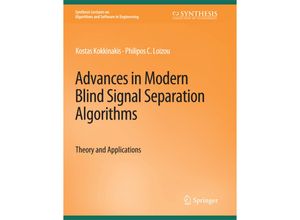With human-computer interactions and hands-free communications becoming overwhelmingly
important in the new millennium recent research efforts have been increasingly focusing on
state-of-the-art multi-microphone signal processing solutions to improve speech intelligibility
in adverse environments. One such prominent statistical signal processing technique is blind
signal separation (BSS). BSS was first introduced in the early 1990s and quickly emerged as an
area of intense research activity showing huge potential in numerous applications. BSS
comprises the task of 'blindly' recovering a set of unknown signals the so-called sources from
their observed mixtures based on very little to almost no prior knowledge about the source
characteristics or the mixing structure. The goal of BSS is to process multi-sensory
observations of an inaccessible set of signals in a manner that reveals their individual (and
original) form by exploiting the spatial and temporal diversity readily accessible through a
multi-microphone configuration. Proceeding blindly exhibits a number of advantages since
assumptions about the room configuration and the source-to-sensor geometry can be relaxed
without affecting overall efficiency. This booklet investigates one of the most commercially
attractive applications of BSS which is the simultaneous recovery of signals inside a
reverberant (naturally echoing) environment using two (or more) microphones. In this paradigm
each microphone captures not only the direct contributions from each source but also several
reflected copies of the original signals at different propagation delays. These recordings are
referred to as the convolutive mixtures of the original sources. The goal of this booklet in
the lecture series is to provide insight on recent advances in algorithms which are ideally
suited for blind signal separation of convolutive speech mixtures. More importantly specific
emphasis is given in practical applications of the developed BSS algorithms associated with
real-life scenarios. The developed algorithms are put in the context of modern DSP devices
such as hearing aids and cochlear implants where design requirements dictate low power
consumption and call for portability and compact size. Along these lines this booklet focuses
on modern BSS algorithms which address (1) the limited amount of processing power and (2) the
small number of microphones available to the end-user. Table of Contents: Fundamentals of blind
signal separation Modern blind signal separation algorithms Application of blind signal
processing strategies to noise reduction for the hearing-impaired Conclusions and future
challenges Bibliography

